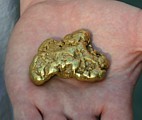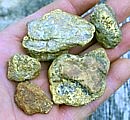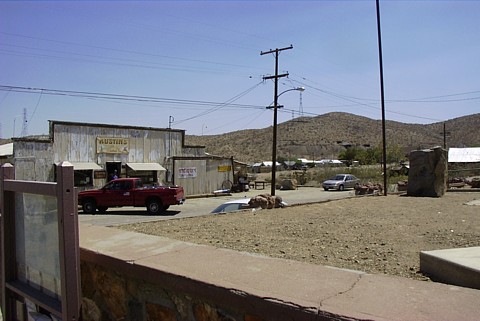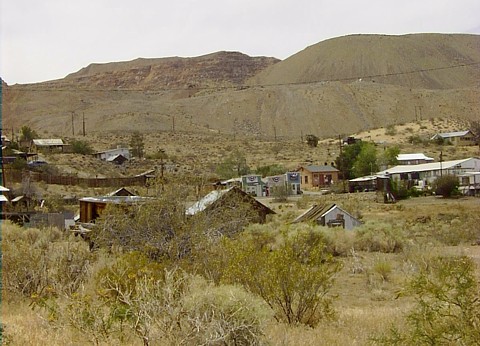Randsburg and The El Paso Range: California Desert Gold Nuggets

.

Randsburg and The El Paso Range: California Desert Gold Nuggets |
 |
||
|
. |
The historic town of Randsburg and the nearby El Paso Range are great places to look for gold and have been attracting prospectors eager for the yellow metal since their discovery more than a century ago. Located only a few hours drive from the greater Los Angeles area, it is very popular with prospectors from southern California. I used to dry wash here regularly myself when I lived in the LA area - and I always got some gold. If you are interested in finding some gold of your own here, take a look at the following information....... |
 |
|
| The Randsburg and El Paso gold
districts have long been of interest to small-scale prospectors using both
dry washers and in more recent times, metal detectors. The Randsburg area
lies near the Kern-San Bernardino County border in the vicinity of the town
of Randsburg, about 40 miles northeast of Mojave and 30 miles north of
Kramer. The El Paso range lies across the valley from the town of Randsburg
to the north and west. The Randsburg district, in Kern County, has been
chiefly a source of hard rock gold, while the El Paso range to the north has
been chiefly a source of placer gold.
Although this region was prospected as early as the 1860s, no significant finds were made at that time. It was not until placer gold was discovered in 1893 in Goler Wash, in the El Paso Mountains 15 miles to the north west, that there was any mineral production. Numerous short-lived dry-washing camps soon sprang up in various locations along the El Paso range. As a result of this activity, the Yellow Aster mine, the most important hard rock mine at Randsburg, was discovered in 1895. Other discoveries were made, and the rich ore recovered in these early operations led to a gold rush. The district was named for the famous Rand district in South Africa. In early years the ore was shipped out of the area for treatment, but a 100-stamp mill was erected at the Yellow Aster mine in 1901 and other mills were built soon after-ward. During the early days some difficulty was encountered in concentrating the placer gold found near Randsburg because of the presence of large chunks of "heavy spar" or scheelite (it is an important Tungsten ore mineral). The Atolia area was an important source of tungsten metal for the US, especially during the times of the two World Wars. |
||
| Large-scale gold mining continued until 1918,
but small-scale placer operations continued through the 1930s,and to a
lesser extent even into the present. The famous
and highly productive Kelly or California Rand silver mine was discovered in
1919 and was operated on a major scale through the 1930s. Gold production
from the district was substantial in the 1930s and continued into the early
1940s. In the early 1990s, a large open pit mine was developed on low grade
ores occurring in brecciated zones found in the Baltic and the Yellow Aster
mine areas. The production of this large operation has only been
curtailed in recent years as the low grade ores are now mined out. The mine
may be reopened because of the current high gold prices. The total gold output of
the district is estimated at more than $20 million through 1960 or roughly
one million ounces. A similar amount of gold is thought to have been mined
from the low grade ores in recent years. If you would like to read
more information on placer mining in general, and some instructions on how
to find your own gold, be sure to check out some pages from my website on gold
mining located
here: |
 |
|
|
|
||
| Geology:
The principal rocks underlying the district are the Precambrian Rand Schist
and the Atolia Quartz Monzonite of Mesozoic age. The Rand Schist is chiefly
biotite schist with smaller amounts of amphibolite and quartzite. To the
east are poorly consolidated clays, sandstones, and conglomerates of
continental origin, which are overlain by
andesite
at Red Mountain.
Rhyolite
and latite intrusives are in the east-central part of the district. To the
north and west in the El Paso range, much of the area is covered by the
Ricardo formation and overlying younger
basalt
rocks. Granitic rocks and older
schists underlie the sediments in the El Paso range. Ore Deposits: Most of the lode gold deposits are found in veins which occur along faults, except at the Yellow Aster mine, where the gold ore is formed in a series of closely spaced veinlets in zone of brecciation. The majority of the gold deposits are in the schist, which is more widespread than the quartz monzonite, and nearly all are in an area where the rocks have been colored a pale red by iron oxides. The veins at Randsburg are not oriented in any specific direction, but usually have a well-defined hanging wall. The ore bodies most commonly occur in the vein footwalls, usually at or near vein intersections or in sheared and brecciated zones. The ore consists of quartz veins with iron oxide-stained brecciated and silicified rock containing native gold in fine grains and varying amounts of sulfides such as pyrite. The sulfides increase at depth, but the gold values decrease. Most mining has stopped where unoxidized sulfides were found in the veins, and the maximum depth of development is 600 feet. Milling ore contains from 1/7 to 1/4 ounce of gold per ton. The higher-grade ore nearly always occurs in pockets near the surface. The Kelly Rand Mine, also located here, yielded large amounts of rich silver ore. |
||
|
Placers: Most of the placer gold from the Randsburg area has been recovered from dry placers at Stringer or in the Rand Mountains north of Randsburg. Some large gold nuggets have been found here. The Stringer area is the source of the largest nugget that the author knows to have been recovered with a metal detector in the lower 48 states of the US. It weighs in at 156 ounces. Gold from the Randsburg area is rough and shows little sign of wear – it is assumed to be derived from the many small quartz stringer veins around the Stringer and Rand Mountains area. In the El Paso Range, gold occurs in modern ravines and stream beds as well as benches above the ravine floor. A series of placers are found along this mountain range, from Last Chance and Bonanza canyons on the west to Summit Diggings on the east. Many of these areas are popular with modern prospectors and are regularly worked by prospectors with dry washers and metal detectors. Many of the placers in the El Paso range have issues with hot basalt rocks which make them difficult to work with many detectors. Gold from the El Paso Range is usually flat, smooth and apparently water worn. Because of the proximity of this rich gold area to the Los Angeles, many prospecting clubs have claims located in the Randsburg and El Paso Range areas. It is not unusual to see a number of folks out here on weekends. |
 |
|
|
|
|
|
.
Want to know a little bit more about this crazy prospector guy? Well, here's a little bit more about me, and how I got into prospecting: Chris' Prospecting Story